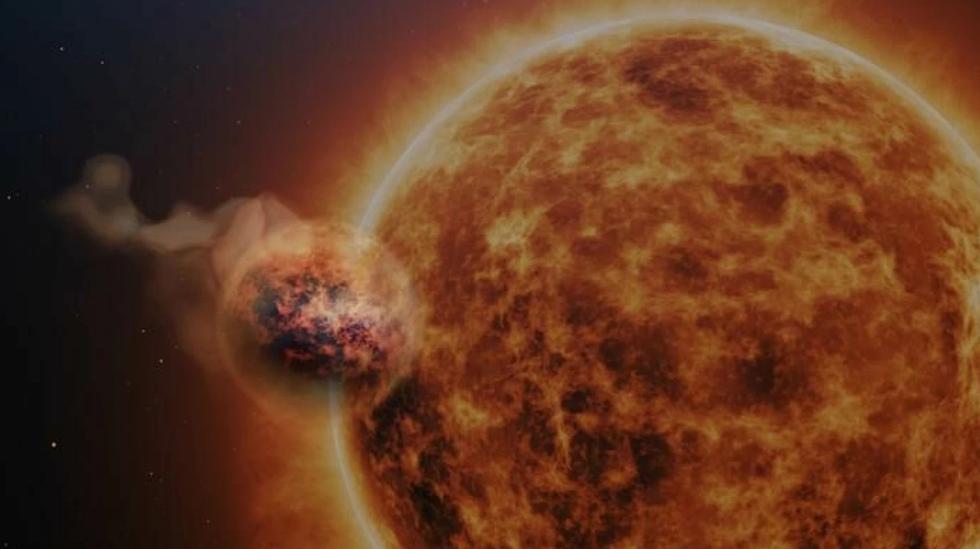On the planet WASP-107b there are clouds of sand and even sand-rain, according to a new study in the journal Nature.
The planet is unlike anything in our solar system.
The gas planet is as massive as Neptune, but as big as Jupiter. This means that it has a low density. The fluffy planet is referred to as a cotton candy planet i a press release from Radboud University in the Netherlands.
Scientists have used the James Webb telescope to look at the planet’s atmosphere.
When the light from a star passes through the atmosphere, it leaves special fingerprints in the light. In this way, researchers can find out more about what kind of substances are found there.
In the atmosphere of WASP-107b there is water vapor, sulfur dioxide and, strangely enough, clouds of small grains of sand.
– The presence of clouds has already been demonstrated on other planets, but this is the first time we see what they are made of. In this case, the answer is silicate, so basically sand, says Nicolas Crouzet at Leiden University in a press release from the university.
The article continues below the advertisementThe article continues below the advertisement
Silicate particles
The planet whizzes around quite close to its star and is quite hot. It is 500 degrees in the outer atmosphere. A year lasts only six days on this planet.
While clouds on Earth are made of water, WASP-107b has clouds of silicate particles.
Silicates are chemical compounds that, among other things, contain the elements silicon and oxygen, according to Store norske lexikon.
95 percent of all mountains on earth consist of silicate minerals. It is also the main component of sand, according to a press release about the new study.
The article continues below the advertisementThe article continues below the advertisement
On WASP-107b, the silicate particles behave like water on Earth.
It evaporates, forming clouds and rain.
Evaporates and turns into clouds again
The sand clouds are found quite far out in the planet’s atmosphere.
– The fact that we see these sand clouds high in the atmosphere must mean that sand and raindrops evaporate in deeper, very hot layers and that the silicate vapor is effectively moved up again. There they condense again and form silicate clouds.
The article continues below the ad
That explains Michiel Min, one of the people who led the study.
– This is very similar to water vapor and the cloud cycle on our own Earth, but with droplets made of sand, says Min, who is a researcher at the SRON Netherlands Institute for Space Research.
Can consist of different things
Scientists have previously known that clouds can theoretically form from things other than water, such as metal, rock or salt, according to American NPR.
– Now we can actually look at it, says Laura Kreidberg, astronomer at the Max Planck Institute for Astronomy.
– It makes the strangeness of a cloud being made of stone feel so real, says Kreidberg. She was not involved in the study.
On Saturn’s moon Titan for example it rains methane.
The sand clouds probably consist of particles that are smaller than sand you find on the beach, says Leen Decin, who was involved in the study, to NPR.
She describes til The Guardian that the clouds would be like misty dust. There are fast winds in the atmosphere. The grains of sand fly around at great speed.
The article continues below the ad
In the process of exploring atmospheres
One of the expectations which was linked to the James Webb telescope was that it would be easier to look at substances in the atmosphere to other planets.
The article continues below the ad
It may even provide hints as to whether the planet is habitable or has signs of life.
The telescope is used to look at the atmospheres of several planets.
In 2022, James Webb demonstrated the first indisputable evidence of carbon dioxide in the atmosphere of an extrasolar planet according to ESA.
In September this year, researchers studied an exotic planet which possibly has a hydrogen atmosphere, liquid oceans and a sulfur compound that is only produced by life here on Earth.
A hot super-Earth called GJ 1214b is also investigated. It is covered by a thick cloud layer containing heavier elements. A super-Earth is a medium-sized planet that is larger than Earth but smaller than the gas giants.
James Webb has also shown that we need to update the image of one of the planets in the exciting solar system Trappist-1. Planet number two in a row is not a Venus twinbut a bare stone without any particular atmosphere.
Reference:
Achrène Dyrek, m. fl.: «SO2, silicate clouds, but no CH4 detected in a warm Neptune», Nature, 15. november. Summary.
(This article was first published at Forskning.no)
2023-11-25 20:26:50
#Startling #revelation


